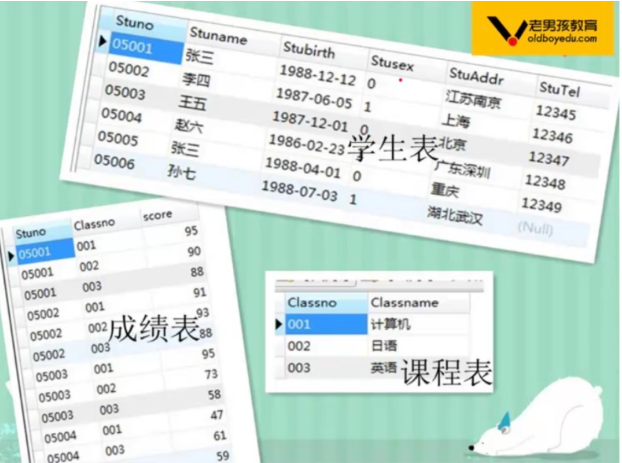四、 MySQL客户端工具及SQL讲解
一.客户端命令介绍
mysql客户端命令
1、用于数据库的连接管理
1) 连接(略)
2) 管理:
3)接收用户的SQL语句
#MySQL接口自带的命令
\h 或 help 或? 查看帮助,查看mysql的管理命令
\G 格式化查看数据(结果以key:value形式展示)
\T 或 tee 记录日志
\c(5.7可以ctrl+c) 结束当前的sql语句
\s 或 status 查看mysql状态信息
\. 或 source 导入SQL数据
\u或 use 切换、使用数据库
\!或system 在数据库中使用系统命令
\q 或 exit 或 quit 退出
2、将用户的SQL语句发送到服务器
mysqladmin客户端管理命令
1、命令行管理工具
mysqldump客户端备份命令
1、备份数据库和表的内容
help命令的使用
mysql> help
mysql> help contents
mysql> help select
mysql> help create
mysql> help create user
mysql> help status
mysql> help show
source命令的使用
#在MySQL中处理输入文件:
#如果这些文件包含SQL语句则称为:
#1.脚本文件
#2.批处理文件
mysql> source /data/mysql/world.sql
#或者使用非交互式
mysql</data/mysql/world.sql
mysqladmin命令的使用
01)“强制回应 (Ping)”服务器。
02)关闭服务器。
03)创建和删除数据库。
04)显示服务器和版本信息。
05)显示或重置服务器状态变量。
06)设置口令。
07)重新刷新授权表。
08)刷新日志文件和高速缓存。
09)启动和停止复制。
10)显示客户机信息。
#查看MySQL存活状态
[root@db01 ~]# mysqladmin -uroot -p123 ping
#查看MySQL状态信息
[root@db01 ~]# mysqladmin -uroot -p123 status
#关闭MySQL进程
[root@db01 ~]# mysqladmin -uroot -p123 shutdown
#查看MySQL当前参数
[root@db01 ~]# mysqladmin -uroot -p123 variables
#库外删除数据库
[root@db01 ~]# mysqladmin -uroot -p123 drop aaa
#库外创建数据库
[root@db01 ~]# mysqladmin -uroot -p123 create aaa
#重载授权表
[root@db01 ~]# mysqladmin -uroot -p123 reload
#刷新binlog日志
[root@db01 ~]# mysqladmin -uroot -p123 flush-log
#刷新缓存主机
[root@db01 ~]# mysqladmin -uroot -p123 reload
#修改密码
[root@db01 ~]# mysqladmin -uroot -p123 password '1'
二.接收用户的SQL语句
1.什么是SQL
结构化的查询语句
2.SQL的种类
DDL:数据定义语言
1)库对象:库名字、库属性
开发规范:库名小写
创建库:create database|schema
Syntax:
CREATE {DATABASE | SCHEMA} [IF NOT EXISTS] db_name
[create_specification] ...
create_specification:
[DEFAULT] CHARACTER SET [=] charset_name
| [DEFAULT] COLLATE [=] collation_name
#创建oldboy数据库
mysql> create database oldboy;
#创建OLDBOY数据库
mysql> create database OLDBOY;
#查看数据库
mysql> show databases;
#查看oldboy的创建语句(DQL)
mysql> show create database oldboy;
#查看创建数据库语句帮助
mysql> help create database
#创建oldboy数据库添加属性
mysql> create database testa charset utf8;
#避免库已存在 报错
mysql> create database if not exists zls;
#规范创建数据库
mysql> create database if not exists test1 default character set utf8 default collate
utf8_general_ci;
mysql> create database if not exists test1 charset utf8 collate utf8_general_ci;
删库:drop database
#删除oldboy数据库
mysql> drop database oldboy;
修改定义库:alter database
mysql> show create database zls1;
+----------+---------------------------------------------------------------+
| Database | Create Database |
+----------+---------------------------------------------------------------+
| zls1 | CREATE DATABASE `zls1` /*!40100 DEFAULT CHARACTER SET utf8 */ |
+----------+---------------------------------------------------------------+
#修改字符集
mysql> alter database zls1 charset gbk;
Query OK, 1 row affected (0.00 sec)
mysql> show create database zls1;
+----------+--------------------------------------------------------------+
| Database | Create Database |
+----------+--------------------------------------------------------------+
| zls1 | CREATE DATABASE `zls1` /*!40100 DEFAULT CHARACTER SET gbk */ |
+----------+--------------------------------------------------------------+
#修改校验规则
mysql> alter database test1 collate utf8_bin;
#修改oldboy数据库属性
mysql> alter database oldboy charset gbk;
#查看oldboy的创建语句(DQL)
mysql> show create database oldboy;
2)表对象:列名、列属性、约束
创建表:create(开发做)
#查看创建表语句帮助
mysql> help create table
#创建表
mysql> create table student(
sid int,
sname varchar(20),
sage tinyint,
sgender enum('m','f'),
cometime datetime);
数据类型
int: 整数 -2^31 ~ 2^31 -1
varchar:字符类型 (变长)
char: 字符类型 (定长)
tinyint: 整数 -128 ~ 128
enum: 枚举类型
datetime: 时间类型 年月日时分秒
int(3) zerofill:显示长度3位,前面显示0自动补全(001 002...)
tinyint unsigned:为整数,正数,0-255
#创建表加其他属性
mysql> create table student(
sid int primary key auto_increment comment '学号',
sname varchar(20) not null comment '学生姓名',
sage tinyint unsigned comment '学生年龄',
sgender enum('m','f') not null default 'm' comment '学生性别',
cometime datetime not null comment '入学时间');
#查看建表语句
mysql> show create table student;
#查看表
mysql> show tables;
#查看表中列的定义信息
mysql> desc student;
数据属性
not null: 非空
primary key: 主键(唯一且非空的)
unique key: 单独的唯一的
pk = uk + not null
auto_increment: 自增(此列必须是:primary key或者unique key)
default: 默认值
unsigned: 非负数(无符号,和数字结合用)
comment: 注释
删除表 :drop
#删除表
mysql> drop table student;
修改表定义:alter 开发做)
#修改表名
mysql> alter table tlbb rename student;
#增加字段
mysql> alter table stu add gsb varchar(10);
#将字段插入到最前面
mysql> alter table stu add youfeng int first;
#将字段插入到某个字段的后面
mysql> alter table stu add xmg int after ljk;
#删除某个字段
mysql> alter table stu drop ljk;
#修改字段的属性
mysql> alter table stu modify qls char(10);
#修改字段名和属性
mysql> alter table stu change qls haoda int;
#修改表名
mysql> alter table student rename stu;
#添加列和列定义
mysql> alter table stu add age int;
#添加多个列
mysql> alter table stu add test varchar(20),add qq int;
#指定位置进行添加列(表首)
mysql> alter table stu add classid varchar(20) first;
#指定位置进行添加列(指定列)
mysql> alter table stu add phone int after age;
#删除指定的列及定义
mysql> alter table stu drop qq;
#修改列及定义(列属性)
mysql> alter table stu modify sid varchar(20);
#修改列及定义(列名及属性)
mysql> alter table stu change phone telphone char(20);
DCL:数据控制语言
针对权限进行控制
grant
grant all on *.* to root@'%' identified by '1';
grant all privileges on *.* to pri2@'%' identified by '1';
grant all on *.* to root@'%' identified by '1' with max_user_connections 1;
#授权root@10.0.0.51用户所有权限(非超级管理员)
mysql> grant all on *.* to root@'10.0.0.51' identified by 'oldboy123';
#怎么去授权一个超级管理员呢?
mysql> grant all on *.* to root@'10.0.0.51' identified by 'oldboy123' with grant option;
#其他参数(扩展)
max_queries_per_hour:一个用户每小时可发出的查询数量
max_updates_per_hour:一个用户每小时可发出的更新数量
max_connetions_per_hour:一个用户每小时可连接到服务器的次数
max_user_connetions:允许同时连接数量
revoke
#收回select权限
mysql> revoke select on *.* from root@'10.0.0.51';
#查看权限
mysql> show grants for root@'10.0.0.51';
DML:数据操作语言
操作表的数据行信息
增 :insert into
#注意:所有值必须一一对应,如果没有就给null
mysql> insert into student2 values(null,'qls',18,'m',now());
#注意:只需要给前面的key添加value,前面key值的顺序可以随意,后面value必须对应
mysql> insert into student2(sname,sage,sgender) values('zls',18,'m');
mysql> insert into student2(sage,sname,sgender) values(18,'zls','m');
#插入多条数据
mysql> insert into student2(sname,sage,sgender) values('zls',18,'m'),('qls',18,'f');
#基础用法,插入数据
mysql> insert into stu values('linux01',1,NOW(),'zhangsan',20,'m',NOW(),110,123456);
#规范用法,插入数据
mysql> insert into stu(classid,birth.sname,sage,sgender,comtime,telnum,qq) values('linux01',1,NOW(),'zhangsan',20,'m',NOW(),110,123456);
#插入多条数据
mysql> insert into stu(classid,birth.sname,sage,sgender,comtime,telnum,qq) values('linux01',1,NOW(),'zhangsan',20,'m',NOW(),110,123456),
('linux02',2,NOW(),'zhangsi',21,'f',NOW(),111,1234567);
改 :update
#不规范
mysql> update student2 set sgender='f';
#规范用法 必须接where条件
mysql> update student2 set sgender='f' where sid=1;
#如果非要全表修改
mysql> update student2 set sage=20 where 1=1;
删 :delete
#不规范
mysql> delete from student;
#规范删除(危险)
mysql> delete from student where sid=3;
mysql> delete from student where sid>3 and sid<9;
#DDL删除表(清空表内容)
mysql> truncate table student;
使用update代替delete做伪删除
1)额外添加一个状态列
mysql> alter table student add status enum('1','0') default 1;
2)使用update
mysql> update student set status='0' where sid=1;
3)应用查询存在的数据
mysql> select * from student where status=1;
DQL:数据查询语言
select:基础用法
#查询city表中的所有内容
mysql> select * from city;
#查询指定列的内容
mysql> select name,countrycode from city;
#指定条件查询
mysql> select * from city where name='afuhan';
#limit(翻页功能)
mysql> select * from city limit 10;
mysql> select * from city limit 10,10;
#多条件查询> 、< 、>=、<=、<>(!=)
mysql> select * from city where countrycode='chn' and population>999999;
#模糊查询
mysql> select * from city where countrycode like 'H%';
mysql> select * from city where countrycode like '%H';
mysql> select * from city where countrycode like '%H%';
#排序(顺序)
mysql> select id,name,population,countrycode from city order by population limit 0,60;
#排序(倒叙)
mysql> select id,name,population,countrycode from city order by population desc limit 0,60;
#group by + 聚合函数
#聚合函数种类:
#max()最大
#min()最小
#avg()平均
#sum()求和
#count()统计
#distinct()差异
#此时此刻,我想吟诗一首
1.遇到统计想函数
2.形容词前group by
3.函数中央是名词
4.列名select后添加
#统计世界上每个国家的总人口数
mysql> sselect countrycode,sum(population)
from city group by countrycode;
#统计中国各个省的人口数量(练习)
不加别名:
mysql> select District,sum(population)
from city
where countrycode='CHN'
group by District order by sum(population);
别名:
mysql> select District as 省,sum(population) as 人口
from city
where countrycode='CHN'
group by 省 order by 人口;
#统每个国家的城市数量(练习)
mysql> select countrycode,count(name)
from city
group by countrycode order by count(name);
#统计中国的城市数量
mysql> select countrycode,count(name)
from city
where countrycode='chn'
group by countrycode order by count(name);
#and(多条件同时满足)
mysql> select * from city
where countrycode='CHN' and id>500;
#or(或者)
mysql> select * from city
where countrycode='CHN' or countrycode='USA';
#in(或者)
mysql> select * from city
where countrycode in ('CHN','USA');
####### 联合查询 效率比in和or高
三.字符集定义
1.什么是字符集(Charset)
字符集:是一个系统支持的所有抽象字符的集合。字符是各种文字和符号的总称,包括各国家文字、标点符号、图形符号、数字等。

2.MySQL数据库的字符集
1)字符集(CHARACTER)
2)校对规则(COLLATION)
3.MySQL中常见的字符集
1)UTF8
2)LATIN1
3)GBK
4.常见校对规则
1)ci:大小写不敏感
2)cs或bin:大小写敏感
5.我们可以使用以下命令查看
mysql> show charset;
mysql> show collation;
四.字符集设置
1.操作系统级别
[root@db01 ~]# source /etc/sysconfig/i18n
[root@db01 ~]# echo $LANG
zh_CN.UTF-8
#C6:
vim /etc/sysconfig/i18n
LANG="en US.UTF-8 "
#C7:
[root@db01 ~]# vim /etc/locale.conf
LANG="en_US.UTF-8"
2.操作系统客户端级别(SSH)
3.MySQL实例级别
方法1:在编译安装时候就指定如下服务器端字符集。
cmake .
-DDEFAULT_CHARSET=utf8 \
-DDEFAULT_COLLATION=utf8_general_ci \
-DWITH_EXTRA_CHARSETS=all \
方法2:在配置文件中设置字符集
#永久
#修改配置文件/etc/my.cnf
[mysqld]
character-set-server=utf8
#临时
mysql> set character_set_server=utf8;
4.建库级别
mysql> create database oldboy charset utf8 default collate=utf8_general_ci;
#建库
mysql> create database db_name charset utf8 collate utf8_xxx_ci;
5.建表级别
mysql> create table test (
id int(4) not null auto_increment,
name char(20) not null,
primary key (id)
) engine=InnoDB auto_increment=13 default charset=utf8;
#建表
mysql> create table tb_name(id int) charset utf8 collate utf8_xxx_ci;
思考问题:如果在生产环境中,字符集不够用或者字符集不合适该怎么处理?

gbk 500-60000
utf8 1-90000
gb2312 2-5000
修改数据库的字符集
mysql> alter database zls charset utf8;
修改表的字符集
mysql> alter table zls charset gbk;
企业中修改某个库中的所有表字符集:
# mysqldump -uroot -p123 -B xx > /tmp/xx.sql
# vim /tmp/xx.sql
# :%s#gbk#utf8#g
# mysql -uroot -p123 < /tmp/xx.sql
update t_char set moneyyb=9999999 where aid=150;
生产环境更改数据库(含数据)字符集的方法
mysql> alter database oldboy character set utf8 collate utf8_general_ci;
mysql> alter table t1 character set utf8;
五.select的高级用法(扩展)
多表连接查询(连表查询)

集合:
[zhang3,li4,wang5]
[50,70,80]
t1:
sid 1 2 3
sname zhang3 li4 wang5
t2:
sid 1 2 3
mark 50 70 80
范式: 减少数据冗余,防止产生一致性问题,把一个表作为一个原子,把一张表拆到不能再拆为止。(开发阶段设计规范)
例:根据两张表的内容查出张三的成绩
select t1.sname,t2.mark from t1,t2 where t1.sid=t2.sid and t1.sname=’zhang3’;
1.传统连接(只能内连接,只能取交集)
#查世界上人口数量小于100的城市在哪个国家,城市和国家人口数量分别是多少?
城市名 国家名 城市人口数量 国家人口数量
city.name country.name city.population country.population
select city.name,country.name,city.population,country.population
from city,country
where city.countrycode=country.code
and city.population<100;
#世界上人口数量小于100的城市在哪个国家,说的什么语言?
select city.population,city.name,country.name,countrylanguage.language
from city,country,countrylanguage
where city.countrycode=country.code
and countrylanguage.countrycode=country.code
and city.population < 100;
2 .natural join(自连接的表要有共同的列名字)
# 人口数量大于1000000的城市所在的国家,他们都说什么语言? (自连接)
select city.population,city.name,city.countrycode,countrylanguage.language
from city natural join countrylanguage
where city.population > 1000000
order by population;
#前提条件:一定要有相同的列名字,并且列中的数据一致
3.企业中多表连接查询 join on(内连接)
#查世界上人口数量小于100的城市在哪个国家,城市和国家人口数量分别是多少?
select city.name,city.population,country.name,country.population
from city join country
on city.countrycode=country.code
where city.population<100;
#世界上人口数量小于100的城市在哪个国家,说的什么语言?
·A join B on 1 join C on 2 join D on 3·
select city.population,city.name,country.name,countrylanguage.language
from city join country
on city.countrycode=country.code
join countrylanguage
on countrylanguage.countrycode=country.code
where city.population < 100;
建议:使用join语句时,小表在前,大表在后。
4.外连接(左外连接,右外连接)
#左外连接
mysql> select city.name as 城市名称,country.code as 国家代码,country.name as 国家名称
from city left join country
on city.countrycodde=country.code
and city.population<100 limit 10;
#右外连接
mysql> select city.name as 城市名称,country.code as 国家代码,country.name as 国家名称
from city right join country
on city.countrycodde=country.code
and city.population<100 limit 10;
5. UNION(合并查询)
####### 联合查询 效率比in和or高
#范围查询OR语句
mysql> select * from city where countrycode='CHN' or countrycode='USA';
#范围查询IN语句
mysql> select * from city where countrycode in ('CHN','USA');
#替换为:
mysql> select * from city where countrycode='CHN'
union all
select * from city where countrycode='USA';
union:去重复合并
union all :不去重复
使用情况:union<union all


